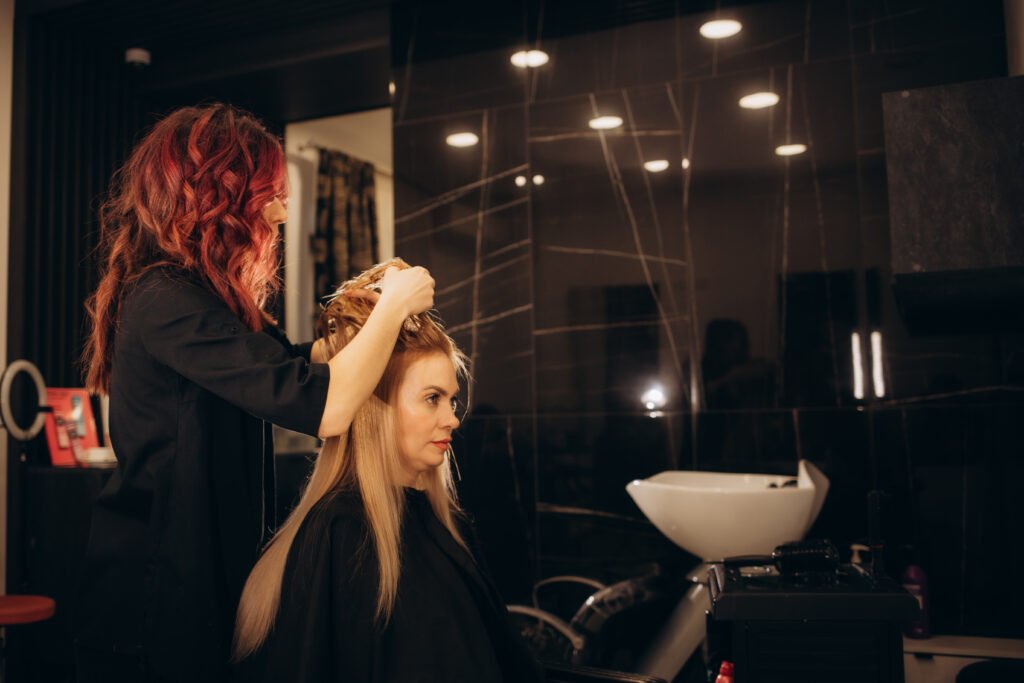- Home
- About
- Features
- Business Owner
- Pricing Plans
- Resources
- Blogs
- Infographics
- FAQ’s
- Help & Support
- Comprehensive Content
- Best Practices to Adopt When Starting a Hair Salon
- Appointment Scheduling Systems: The Complete Handbook
- Smoothen the Journey of Opening a Yoga Studio: A Comprehensive Guide
- Tips and tricks to increase revenue Growth of your Fitness studio
- How Pre- Appointment Consultation forms can transform you nail Art Experience?
- Login/Signup
How Pre- Appointment Consultation forms can transform you nail Art Experience?
Preappointment consultation forms, which provide a more individualized and effective approach, are completely changing the nail art experience. When these papers are filled out ahead of time, nail technicians can learn more about your tastes, the condition of your nails, and your inspiration for the design.
Early awareness of your preferences enables the technician to customize a service that fits your particular style and makes the most of your appointment time while focussing on getting the results you want.

Table of Contents
ToggleThese forms offer a clear basis for communication, removing any uncertainty and misunderstandings, whether you’re going for a minimalist style, elaborate nail art, or have particular nail care concerns. By guaranteeing a seamless, personalized service, this proactive approach not only saves time during the visit but also improves the overall customer experience. In the end, Pre-appointment consultation forms turn normal nail treatments into fun, highly personalised experiences that precisely match your vision.
How pre appointment consultation can help clients and salon owners?
By improving communication and the entire service experience, pre-appointment consultation forms prove to be very beneficial to both salon owners and customers. Salon operators can prepare the appropriate tools, materials, and designs ahead of time by using these questionnaires, which offer insightful information about a client’s preferences, nail health, and particular requests prior to the appointment. This ensures a better workflow, decreases guesswork, and increases service efficiency all while saving time.
In order to provide clients with a more tailored and fulfilling experience, consultation forms make sure that their specific requirements and preferences are recognised and taken care of right away. It also improves safety and comfort during the service to let people know in advance about any allergies, sensitivities, or concerns.
Pre-appointment consultation forms, in general, improve communication, raise client satisfaction, and assist salon operators in providing more individualized treatment. Pre-appointment consultation forms streamline communication and improve the overall service experience, which benefits both salon owners and customers. These forms give salon owners useful information about their clients’ preferences, nail health, and special requests before the appointment, enabling them to set up the equipment, supplies, and designs ahead of time. In addition to saving time, this increases service effectiveness by lowering uncertainty and guaranteeing a more seamless workflow. Consultation forms give clients the assurance that their particular requirements and preferences are recognized and taken care of right away, making their experience more individualized and fulfilling.
1. Understanding Consultation forms
Before a client’s appointment, hairdressers, nail artists and other service providers use consultation forms to obtain vital information from them. Usually, this form asks about the client’s aims and preferences as well as any pertinent health or lifestyle information that can affect the service, including allergies or sensitivity issues. In the beauty business, consultation forms are very helpful in learning about a client’s past experiences, stylistic preferences, and any particular worries they might have. A more individualized and effective service can be provided by the service provider by gathering this information ahead of time and customizing the encounter to the client’s specific requirements. In addition to lowering misconceptions and raising satisfaction levels, consultation forms facilitate straightforward communication between the professional and the customer.
2. Elements of a salon or nail art Consultation form

2.1 Client’s Data
Name, phone number, and scheduled appointment time to keep records and get in touch with the client when necessary.
2.2 History of Skin and Nail Health
Details regarding the condition of the client’s nails, including brittleness, past injuries, or infections.
For safety reasons, additional questions about allergies, skin disorders, and sensitivity to particular materials, such as gels or acrylics, are added.
2.3 Preferences for Services
Information regarding the client’s desired nail length, shape, and any particular styles or designs they may be interested in. This aids technicians in having the appropriate equipment and supplies ready in advance.
2.4 Earlier Nail Procedures
Details regarding previous procedures, such as gels, acrylics, or other improvements, in order to determine the best course of action for the present service.
2.5 Sensitivities and Allergies
To guarantee the service is secure and comfortable, there is a part to indicate any product allergies (e.g., latex, acetone) or skin sensitivity.
2.6 Lifestyle Points to Consider
Inquiries on the client’s interests and way of life (such as employment and hobbies) to suggest the longest-lasting nail art designs or treatments.
2.7 Particular Enquiries or Fears
A place where clients can express any particular requests or worries they may have, whether related to a special occasion or an original design.
2.8 Assent and Recognition
A concluding portion in which the client grants permission for the treatment and acknowledges agreement to the salon’s policies, including conditions of cancellation and product use.
These elements guarantee that the client will receive a customized, secure, and pleasurable service from the salon.
2.9 Continual Updates
Check the form from time to time to make sure it’s still accurate and current with any modifications to salon services or new rules about the business.
You may build a thorough consultation form that promotes client safety, strengthens communication, and helps your salon provide individualized services by following these steps.
3. How to create a consultation form for salon?

A methodical strategy is needed when creating a consultation form for a salon to guarantee that all the information required for a safe and customized client experience is collected. Here’s a detailed tutorial on how to draft a successful consultation form:
3.1 Establish the Objective
Decide on the precise objectives of the form, such as obtaining health data, comprehending customer choices, guaranteeing security, and complying with regulatory criteria. This influences how the form’s content is shaped.
3.2 Define Important Information Domains
Add sections that will provide readers with a thorough grasp of the client’s requirements and state of health: Name, contact details, and appointment details are personal details.
Questions concerning allergies, sensitivities, and conditions about the skin and nails.
Service Preferences: Favourite nail design, length, shape, and previous nail care procedures.
Aspects of Lifestyle: In what manner the daily activities of a customer, such as job or hobbies, may influence their nail care requirements.
Special Requests: Any particular demands you may have for services, nail art, or other matters.
Consent: Acknowledgement of all hazards and consent to continue with the service.
3.3 Add Questions About Safety and Health
Enquire about any health issues, allergies, or sensitivities that may impact the course of treatment, such as skin problems or chemical sensitivity to nail polish.
To legally protect the salon, including disclaimers and liability waivers where necessary.
3.4 Make Sure the Language Is Clear
Use straightforward language to help people understand the form.
Steer clear of highly technical or intricate language. The intention is not to confuse the client, but to promote conversation.
3.5 Include the Consent Section
Add a clause stating that the client has agreed to the course of treatment and acknowledges sharing pertinent health information.
This section may also include disclaimers about products or the salon’s cancellation policy.
3.6 Pick the Appropriate Format
Paper Forms: Provide clients with paper forms to complete during their visit.
Digital Forms: Before appointments, transmit consultation forms via online platforms or salon management software. Time is saved and more effective record-keeping is made possible by this.
3.7 Create the layout
Make sure each section has a distinct heading and is cleanly organized.
To make forms easier for clients to complete, provide checkboxes, multiple-choice questions, and short answer fields.
3.8 Check the Document
Staff members or a select clientele should test the form to make sure it’s user-friendly and gathers the required data. Make changes in response to criticism.
4. Understanding the advantages of using consent forms in salons

We must grasp the challenges that business professional
Legal Protection: Assures that consumers are aware of the dangers associated with specific procedures, protecting the salon from possible liability.
Clear Communication: Prevents miscommunications between clients and technicians by outlining expectations for the service in a transparent manner.
Client safety: Ensures treatments are carried out safely and appropriately by gathering vital health information (such as allergies and skin disorders).
Professionalism: Promotes customer care, safety, and ethical behaviour while strengthening the salon’s reputation.
Keeping Records: Offers a history of services and treatments that is documented and helpful for upcoming visits or in case of problems.
Ensuring clients are well-educated about treatments, products, and potential adverse effects is crucial to promoting informed decision-making and building confidence.
Regulation Compliance: Assists the salon in adhering to any applicable municipal laws and industry standards. You need to record the consent of the client.
Increased Customer Satisfaction: Knowing that their preferences and well-being are duly considered makes clients feel more confident and appreciated.
5. Crucial steps for consultation of nail art
A good consultation for nail art guarantees that the client and the technician agree with expectations, preferences, and any essential safety measures. The essential steps for a consultation on nail art are as follows:
5.1 Compile customer data
Start by getting the client’s name, contact information, and appointment date as well as other vital personal information. This keeps documentation for the next appointments and follow-ups.
5.2 Examine Your Skin and Nails
Enquire the customer about the condition of their nails, including any problems such as brittleness, infections, or sensitivity. Ask about any skin issues that might interfere with the service in the area surrounding the nails. This guarantees that the technician will be able to suggest appropriate care and prevent issues.
5.3 Go Through Style and Preferences
Recognize the client’s inclinations for style, such as preferred nail length, shapes (almond, coffin), colors, and Patterns. To further understand the client’s style, try to get them to share inspirational photos or point to designs from earlier projects that they enjoyed.
5.4 Examine Lifestyle Elements
Talk about how the client’s occupation, hobbies, or daily schedule may affect how long the nail art will last and how useful it is. For instance, people who work with their hands may need longer nails or more robust nail polishes, such as gel or acrylic.
5.5 Consider Previous Nail Treatments
Examine any prior procedures, including nail extensions, gel paint, and acrylic nails. Knowing what has and has not worked for the client in the past can assist direct the present service and prevent mistakes from being made again.
5.6 Look for sensitivity and allergy information
Enquire about any allergies or sensitivity issues with regard to particular nail care products, such as latex gloves, gels, or acrylics. Preventing unfavourable reactions during the service requires taking this crucial step.
5.7 Go over upkeep and aftermath
Describe the level of care needed for the nail art, including suggestions for aftercare to ensure durability. This could mean suggesting items for at-home care or touch-up appointments.
5.8 Have Reasonable Aspirations
Give the client’s desired nail art clear instructions on its duration, cost, and restrictions. This move helps manage expectations by ensuring that the client is aware of what is practical in light of their intended design, financial limits, and nail condition.
5.9 Individualised and tailored requests
Permit the buyer to specify any unique requirements, such as custom designs, themed nail art, or customised nail enhancements. A satisfying experience requires that the service be customised to their goals.
5.10 Reach a Consent
Verify the patient’s consent and that they are informed of the treatment’s risks and side effects. This is particularly important for operations where you may be working with chemicals, extensions, or treatments that could affect the condition of your nails.
